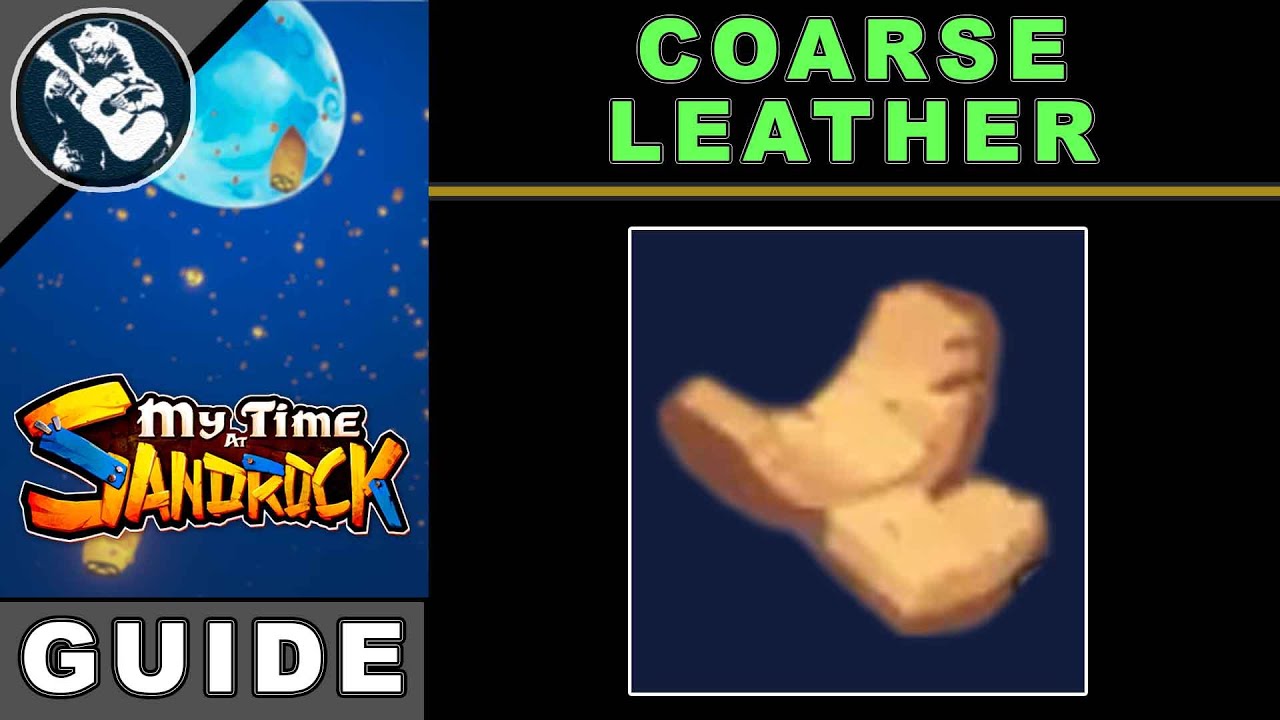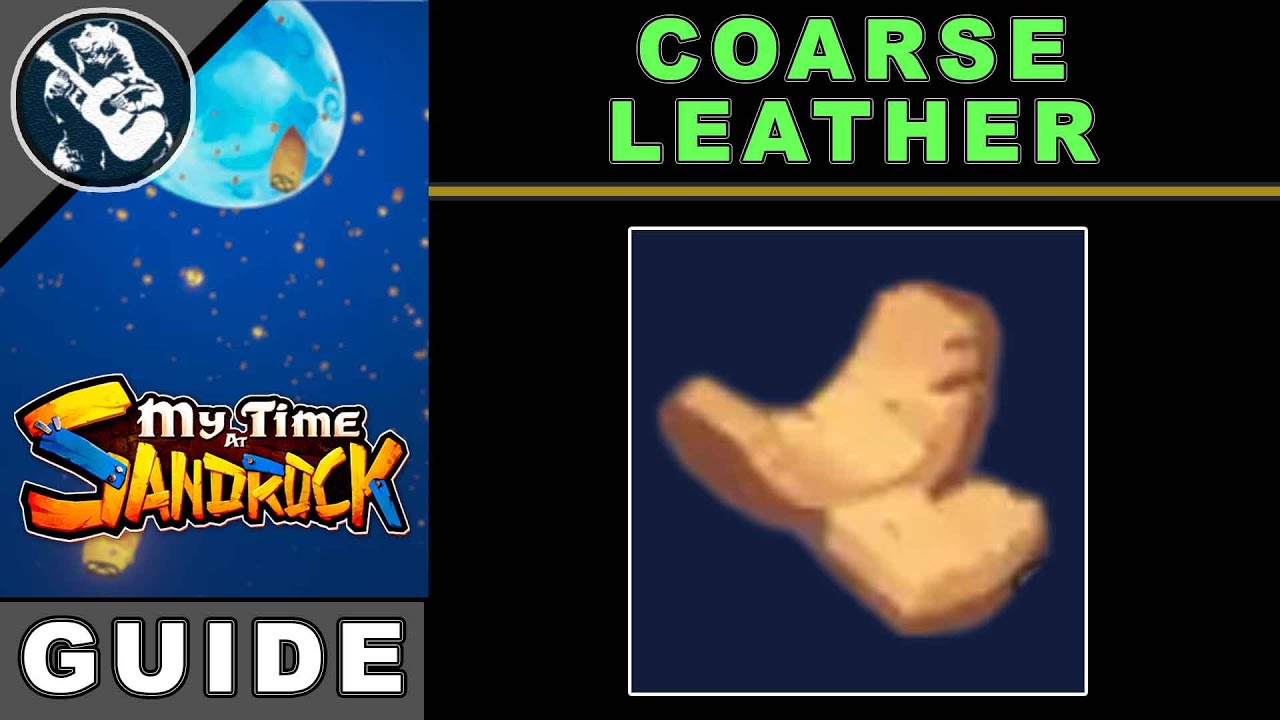My time at sandrock basic leather – Embark on a journey through My Time at Sandrock: Basic Leather, where we delve into the art of crafting and utilizing this versatile material. From its definition and acquisition to its applications and aesthetic potential, this guide unveils the secrets of basic leather, empowering you to elevate your gameplay and unleash your creativity.
In this comprehensive exploration, we’ll uncover the different types of leather, their properties, and the factors to consider when selecting the perfect leather for your crafting needs. We’ll provide step-by-step instructions for crafting various items, highlighting the benefits and drawbacks of using basic leather in different projects.
My Time at Sandrock: Basic Leather

Basic leather is a fundamental material in My Time at Sandrock, a crafting and building simulation game. It serves as a versatile resource used in constructing various items, including tools, furniture, and clothing.
Obtaining and Crafting Basic Leather
To obtain basic leather, players must first gather raw animal hides from creatures in the wild or purchase them from merchants. These hides can then be processed into leather through the Tanning Tub workshop. The process involves cleaning, soaking, and tanning the hides, transforming them into supple and durable leather.
Optimizing Basic Leather Production
To maximize basic leather production, players can implement several strategies:
- Efficient Gathering:Prioritize hunting animals that yield large hides, such as bears and wolves. Utilize traps and other hunting techniques to increase the chances of successful hunts.
- Tanning Efficiency:Upgrade the Tanning Tub workshop to reduce the time required for tanning hides. Consider assigning skilled workers to the workshop for faster production.
- Resource Management:Establish a steady supply of raw hides by regularly hunting or purchasing them. Monitor the inventory and ensure there are sufficient resources to meet production demands.
- Bulk Production:Process multiple hides simultaneously by placing them in the Tanning Tub together. This method can significantly increase leather output over time.
Types of Leather
Leather is a versatile material that can be used for a variety of purposes in My Time at Sandrock. There are several different types of leather available in the game, each with its own unique properties and uses.
The following are the main types of leather in My Time at Sandrock:
Cow Leather
- Cow leather is the most common type of leather in the game. It is strong and durable, making it a good choice for a variety of applications.
- Cow leather is also relatively inexpensive, making it a good option for budget-minded players.
Goat Leather
- Goat leather is softer and more pliable than cow leather, making it a good choice for clothing and other items that require flexibility.
- Goat leather is also more water-resistant than cow leather, making it a good choice for items that will be exposed to the elements.
Sheep Leather
- Sheep leather is the softest and most pliable type of leather in the game. It is a good choice for clothing and other items that require a luxurious feel.
- Sheep leather is also more expensive than cow leather and goat leather, making it a less budget-friendly option.
Factors to Consider When Choosing Leather
When choosing leather for a specific purpose, there are several factors to consider:
- Strength and durability:Some types of leather are more durable than others. If you need leather that will be able to withstand wear and tear, you should choose a stronger type of leather, such as cow leather.
- Flexibility:Some types of leather are more flexible than others. If you need leather that will be able to move with you, you should choose a more flexible type of leather, such as goat leather.
- Water resistance:Some types of leather are more water-resistant than others. If you need leather that will be able to withstand water, you should choose a more water-resistant type of leather, such as goat leather.
- Price:Some types of leather are more expensive than others. If you are on a budget, you should choose a less expensive type of leather, such as cow leather.
Crafting with Basic Leather
Basic leather is a versatile material that can be used to craft a wide variety of items. It is relatively inexpensive and easy to work with, making it a great choice for beginners. However, it is important to note that basic leather is not as durable as some other types of leather, so it is not suitable for all projects.
Some of the most popular items that can be crafted with basic leather include:
- Bags
- Wallets
- Belts
- Jewelry
- Home décor
To craft with basic leather, you will need a few basic tools and materials. These include:
- Leather
- Scissors
- A ruler or measuring tape
- A leather punch
- Leather needles
- Leather thread
Once you have your tools and materials, you can begin crafting your project. The first step is to cut the leather to the desired size and shape. Once the leather is cut, you can begin punching holes for the stitching.
The holes should be evenly spaced and about 1/4 inch apart.
Once the holes are punched, you can begin stitching the leather together. Use a strong leather thread and a saddle stitch to ensure that the seams are secure. Once the stitching is complete, your project is finished.
Basic leather is a great material for crafting a variety of items. It is relatively inexpensive and easy to work with, making it a great choice for beginners. However, it is important to note that basic leather is not as durable as some other types of leather, so it is not suitable for all projects.
Applications and Uses
Basic leather finds extensive applications in various industries and professions in My Time at Sandrock, serving a multitude of purposes. Its durability, flexibility, and versatility make it an ideal material for a wide range of products and applications.
Crafting
Basic leather is a fundamental material used in crafting various items in My Time at Sandrock. It is employed in the creation of essential tools, such as bags, belts, and pouches, which aid in organizing and transporting items. Leather is also utilized in the crafting of furniture, adding comfort and durability to chairs, sofas, and other furnishings.
Building and Construction
In the realm of building and construction, basic leather is employed for its strength and weather resistance. It is used as a roofing material, providing protection from the elements, and as a component in the construction of tents and other temporary structures.
Leather is also utilized in the creation of insulation materials, contributing to the thermal efficiency of buildings.
Fashion and Accessories
The fashion industry heavily relies on basic leather for its aesthetic appeal and durability. It is used in the production of clothing, footwear, and accessories, including jackets, shoes, bags, and belts. Leather’s ability to take on different textures, colors, and finishes makes it a versatile material for creating stylish and functional fashion items.
Real-World Applications
Beyond the virtual world of My Time at Sandrock, basic leather has a wide range of real-world applications. It is employed in the automotive industry for upholstery and interior components. In the military, leather is used in the production of protective gear, such as boots, gloves, and helmets.
Additionally, leather finds use in the medical field, where it is utilized in the manufacturing of medical equipment and prosthetics.
Design and Aesthetics
Working with basic leather involves careful consideration of design principles and aesthetic elements. Understanding the material’s properties and limitations allows for the creation of unique and visually appealing items.
One key aspect of leather design is its malleability. Basic leather can be manipulated and shaped in various ways, including cutting, embossing, tooling, and carving. These techniques enable the creation of intricate patterns, textures, and three-dimensional forms.
Color and Texture
The color and texture of basic leather play a significant role in its aesthetic appeal. Natural leather exhibits a range of hues from light tan to deep brown, while dyed leather offers a wider palette of options. The texture of leather can vary from smooth and supple to rough and grained, depending on the tanning process and the type of animal hide used.
Shape and Form, My time at sandrock basic leather
The shape and form of leather items can greatly influence their overall design. Basic leather can be cut into various shapes, from simple geometric forms to complex organic contours. The use of stitching, rivets, and other hardware can further enhance the visual interest and structural integrity of leather goods.
Inspiration and Ideas
Inspiration for creating aesthetically pleasing items using basic leather can be found in various sources. Nature, architecture, and fashion can provide endless ideas for patterns, textures, and color combinations. Experimentation with different techniques and materials can also lead to innovative and unique designs.
Wrap-Up: My Time At Sandrock Basic Leather
As we conclude our exploration of My Time at Sandrock: Basic Leather, remember that this material is not merely a resource but a canvas for your imagination. With the knowledge and techniques acquired through this guide, you now possess the power to transform basic leather into extraordinary creations, shaping the world of Sandrock and leaving your unique mark on its vibrant community.
Clarifying Questions
What is the significance of basic leather in My Time at Sandrock?
Basic leather is a fundamental material used in various industries and professions within My Time at Sandrock. It serves as a versatile resource for crafting items, ranging from clothing and accessories to furniture and building materials.
How can I obtain basic leather?
Basic leather is primarily obtained by processing raw hides acquired from animals such as cows and sheep. You’ll need a Tanning Rack and the necessary resources to complete the tanning process.
What are some tips for optimizing basic leather production?
To maximize your basic leather yield, ensure you have a steady supply of raw hides. Consider investing in upgrades for your Tanning Rack to increase efficiency and production capacity. Additionally, maintaining a well-organized workshop and optimizing your workflow can streamline the tanning process.

